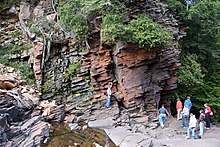Potsdam Sandstone
| Potsdam Sandstone | |
|---|---|
| Stratigraphic range: Latest | |
 Old Snell Hall at Clarkson University was built with Potsdam Sandstone.[3] | |
| Type | Geological formation |
| Sub-units |
|
| Area | Eastern North America |
| Lithology | |
| Primary | Orthoquartzite |
| Other | Conglomerates, local siltstone lenses[7] |
The Potsdam Sandstone, more formally known as the Potsdam Group, is a
Name and type locality

The Potsdam Sandstone is named for its type locality in Potsdam, New York, where in 1838 Ebenezer Emmons described it in outcrops along the Raquette River.[9][10]
Stratigraphic setting and lithology

The Potsdam Sandstone lies
As sea level rose in the depositional environment, increasing amounts of carbonate minerals were deposited in the sediment, with the result that the unit grades upward into dolomitic sandstone in the upper Potsdam and then to sandy dolomite at the base of the overlying Theresa Formation.[8][12][14]
Paleontology


Fossil remains of whole animals are rare in the Potsdam Sandstone, but there are some significant occurrences of trace fossils. Trace fossils in the unit include both vertical burrows, such as Diplocraterion and Skolithos and horizontal trackways, such as Diplichnites, Protichnites, and Climactichnites.[11][15] In 1903, a 20-ton (18-tonne) slab of Potsdam Sandstone from Clinton County, New York, displaying tracks attributed to trilobites, was placed in the New York State Museum.[16] Fossil impressions of the whole bodies of jellyfish have also been found in the Potsdam.[11]
Geographic occurrence
In New York state, the Potsdam is found primarily north and west of the
Uses in construction and industry
In the 19th century, Potsdam Sandstone was highly regarded as a building material. There was extensive
Local sandstone was used for many buildings in Potsdam, as well as for purposes such as
Stratigraphically equivalent and lithologically similar sandstone extends across the international border into
Historically the name "Potsdam sandstone" was also applied to various other North American sandstone bodies that directly overlie
See also
References
- ^ Salad Hersi, O. & Lavoie, D. (2000). "Lithostratigraphic revision of the Upper Cambrian Cairnside Formation, upper Potsdam Group, southwestern Quebec. Geol. Surv. Canada, Curr. Res. D4, 1–8" (PDF).
{{cite journal}}: Cite journal requires|journal=(help) - ISBN 9780891813804.
- ^ a b c A Short History of Potsdam Sandstone, Potsdam Public Museum website, accessed July 29, 2011
- ^ Lavoie, D; Hamblin, A P; Thúriault, R; Beaulieu, J; Kirkwood, D. Geological Survey of Canada, Open File 5900.
- ^ "Covey Hill Formation".
- ^ "Compendium of Rocks Units in Indiana - A Revision".
- .
- ^ a b c d e f g h James Carl, Potsdam Sandstone: Composition and Qualities, Potsdam Public Museum website, accessed July 29, 2011
- U.S. Geological SurveyGeolex Database, accessed August 1, 2011
- ^ a b James Carl, Potsdam Sandstone: Bedrock Geology, Potsdam Public Museum website, accessed July 29, 2011
- ^
- ^ a b c d e John H. Williams, Richard J. Reynolds, David A. Franzi, Edwin A. Romanowicz, and Frederick L. Paillet (2010), Hydrogeology of the Potsdam Sandstone in Northern New York, Canadian Water Resources Journal Vol. 35(4): 399–416 (2010)
- S2CID 130051546.
- ^ Mineral Resources On-Line Spatial Data: Theresa Formation, U.S. Geological Survey Geolex, accessed August 6, 2011
- ^ James Carl, Rock Structures and Fossils, Potsdam Public Museum website, accessed July 29, 2011
- ^ The Trail of the Serpent, The New York Times, November 12, 1903
- ^ a b c The Potsdam Red Sandstone quarries, Scientific American, January 7, 1893, page 8-10.
- ^ a b c d e Potsdam Sandstone office (photo and description), New York Heritage website, accessed July 29, 2011
- ^ Lori Shull, Consultant tracking Potsdam sandstone, NNY stonemasons, Watertown (N.Y.) Daily Times, September 20, 2010
- ^ Architectural sandstone quarrying in Québec, Québec Ministry of Natural Resources and Wildlife website, accessed August 1, 2011
- ^ Potsdam sandstone Archived 2011-07-04 at the Wayback Machine, University of Waterloo Earth and Environmental Sciences website, accessed July 29, 2011
- ^ a b Thomas W. Bjerstedt and J. Mark Erickson (1989), Trace Fossils and Bioturbation in Peritidal Facies of the Potsdam-Theresa Formations (Cambrian-Ordovician), Northwest Adirondacks, Palaios, Vol. 4, No. 3, June 1989, pp. 203-224
- ^ a b Indiana Geological Survey, Potsdam Supergroup, St. Croixan Series, Cambrian System and Mount Simon Sandstone, Potsdam Supergroup, Cambrian System, accessed July 29, 2011
- ^ a b Charles Doolittle Walcott (1891), Correlation Papers: Cambrian, Bulletin of the U.S. Geological Survey, volume 15.
- ISBN 0-387-96350-2. Page 181.
External links
- "The Potsdam Red Sandstone Quarries". Scientific American, Vol. LXVIII, No. 1, New York, January 7, 1893, pp. 1, 8–10.
- "The Potsdam Red Sandstone Company’s Water Wheel". Scientific American, Vol. LXVIII, No. 3, January 21, 1893, pp. 37–38.
